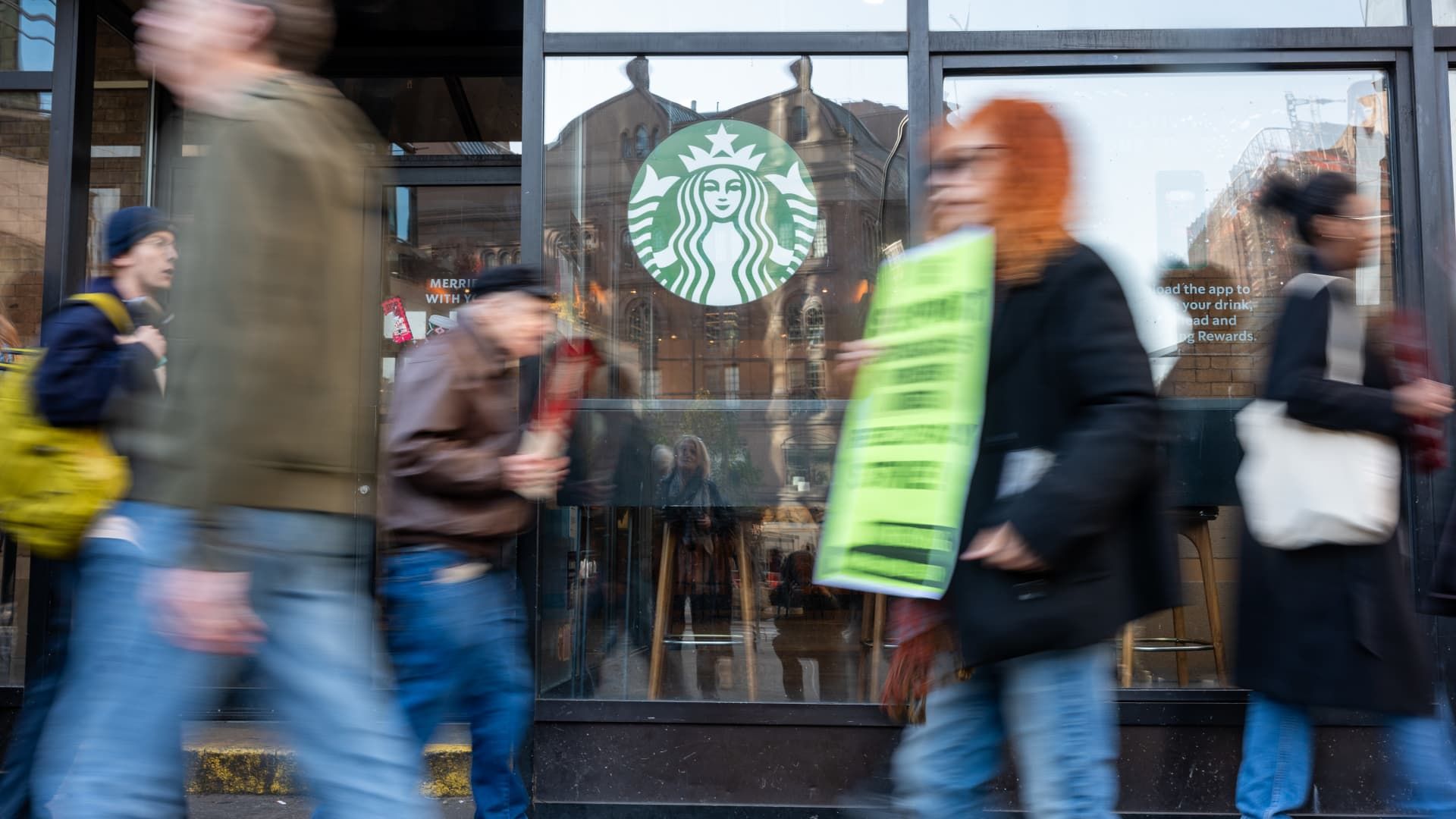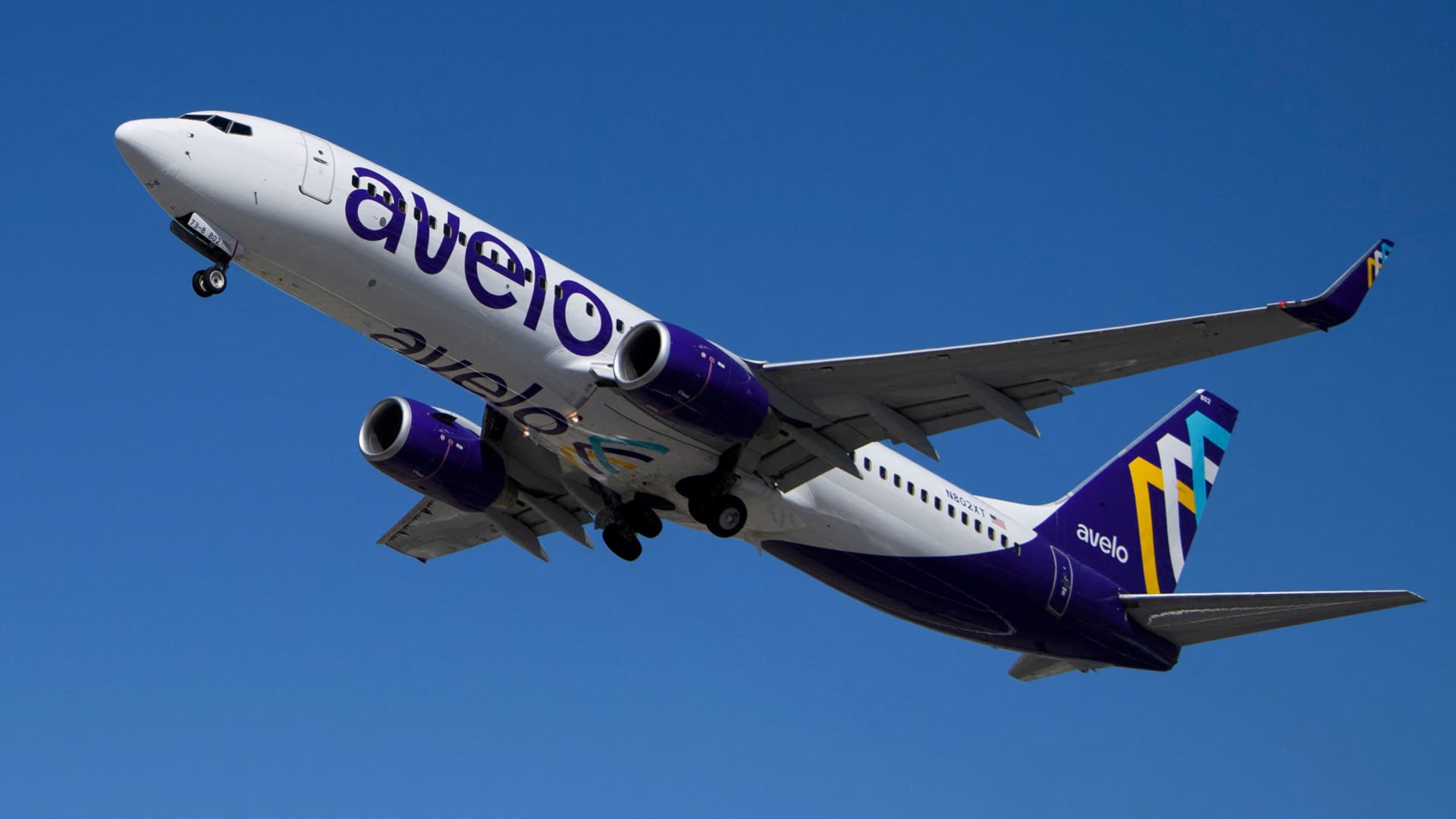People picket outside a Starbucks store in New York's East Village on November 16, 2023.
Spencer Platt | fake images
When starbucks and its barista union resume contract negotiations this week, workers may have renewed momentum behind them, courtesy of the company's own CEO.
Last month, the coffee giant found itself reporting an objectively challenging quarter. Comparable sales in the United States fell 3% and traffic fell 7%. As a result, the company cut its 2024 guidance.
CEO Laxman Narasimhan admitted that Starbucks was seeing a more cautious consumer when it came to spending, but also cited the need to make improvements in stores as the company saw worrying trends. Starbucks reported mobile app incomplete order rates in the mid-teens and said casual customers were coming in less.
Narasimhan, in comments prepared for Wall Street analysts, cited some of the challenges that union workers have been highlighting as they seek to improve working conditions.
“Specifically in our US stores, we are focused on creating a more stable environment for partners through investments in equipment innovation, process improvements, staffing, scheduling and waste reduction, all of which our partners value and prioritize creating a more satisfying work environment in our stores while de-risking our business,” Narasimhan said in a call with analysts.
He added in an interview with CNBC's “Squawk on the Street” that performance has improved and said the company's roadmap will continue to build on that momentum with store improvements and better value communication.
“We have improved the speed of service quarter after quarter. If we look at the processes that we are implementing, particularly in the peaks, what we find is that we have opportunities to improve them even more with changes to the processes and tools that we provide to partners at the peak,” Narasimhan said.
For Workers United, the union behind the Starbucks organizing, their admission that more could be done was promising.
Staffing challenges
Organizing efforts began nearly three years ago in Buffalo, New York, under the direction of then-CEO Kevin Johnson. At the time, Starbucks was a company long known for its progressive worker benefits.
But baristas, emboldened by their experience during the Covid-19 pandemic, pushed for changes to the company's cafes. More than 430 unionized stores and two CEOs later, the two sides have made “significant progress” in contract negotiations, taking a more optimistic tone after a successful two-day session last month.
Starbucks and the union are meeting to continue working on the framework that will inform each store contract going forward.
“I think right now we're seeing the company recognize that there are problems, major problems,” Michelle Eisen, a Workers United delegate and original member of the company's first organized union in Buffalo, told CNBC before the negotiations.
“We heard Narasimhan make that statement after the earnings call that they are aware that stores have been experiencing staffing issues,” said Eisen, who has been with the company for more than a decade and is among 150 delegates who attend in-person bargaining sessions with Starbucks on behalf of the union.
“I think it's a new world right now to be able to say that the CEO has stepped up and said, 'Look, we have some problems, we know we have some problems, we want to work to solve these problems,'” Eisen said. “And as a worker in a unionized location, with proposals on the table to help solve these problems, that's exactly what I want to hear.”
In internal surveys and at bargaining committee meetings, union-represented partners consistently rank “staffing and scheduling” as their top priority issue. The vast majority of represented partners report that they are frequently short-staffed, and a simple majority of partners report that they are scheduled for fewer hours than they want or need.
The union has also pushed for better wages and benefits.
Starbucks says it has made significant progress over the past two years in staffing and scheduling. An advanced staffing model can take into account both historical trends in assigned hours per store and current trends, types of products available and upcoming promotions, the company said. Starbucks says its data shows that associates are now getting more hours and that associate retention and sentiment have increased across the United States as schedules become more stable and consistent.
Orders up
Staffing improvements are likely to become even more important as Starbucks projects an increase in traffic and orders.
In July, Starbucks plans to open its mobile ordering and payment app to non-rewards members in a bid to win back its casual customer base. This will create the ability to target all customers with new products and promotions in an effort to increase traffic.
It will also introduce what it calls the Siren System: new equipment and protocol to address customer ticket times. The Siren system includes a custom ice dispenser, milk dispensing system and faster blenders to reduce baristas' steps and deliver drinks to customers faster. It will reach 1,000 stores in July.
“It's a terrible feeling to be on that floor and peel off a sticker and look at the time and then look at the clock on the wall and realize you're already 8 minutes late,” Eisen said of mobile ordering.
“Eight minutes doesn't seem like a lot. But when you're churning out 100 transactions every half hour… and you realize you probably have 20 drinks backed up, it's a bad feeling,” he said.
There has been another call for change at Starbucks stores that may have weight at the negotiating table. Former Starbucks CEO Howard Schultz, in a LinkedIn post after the company's earnings report, said management needs to spend more time with workers to understand current challenges.
It was the third time he has intervened publicly about Starbucks and its operations since leaving the company and its board of directors last year. It was a notable change in tone from when Schultz returned to the company in 2022 to respond to the union challenge, with a much more combative attitude.
Narasimhan was mentored by Schultz for six months before taking the helm of the company, and spent time in stores with baristas, including earning his barista certification before becoming CEO in 2023.
“I have emphasized that the company's solution must begin at home: the US operations are the main reason for the company's fall from grace,” Schultz said. “Stores require a manic focus on the customer experience, through the eyes of a merchant. The answer is not in the data, but in the stores.”
At the time, the coffee giant responded: “We always appreciate Howard's perspective. We are focused on the challenges and opportunities he highlights. And like Howard, we are confident in Starbucks' long-term success.”









